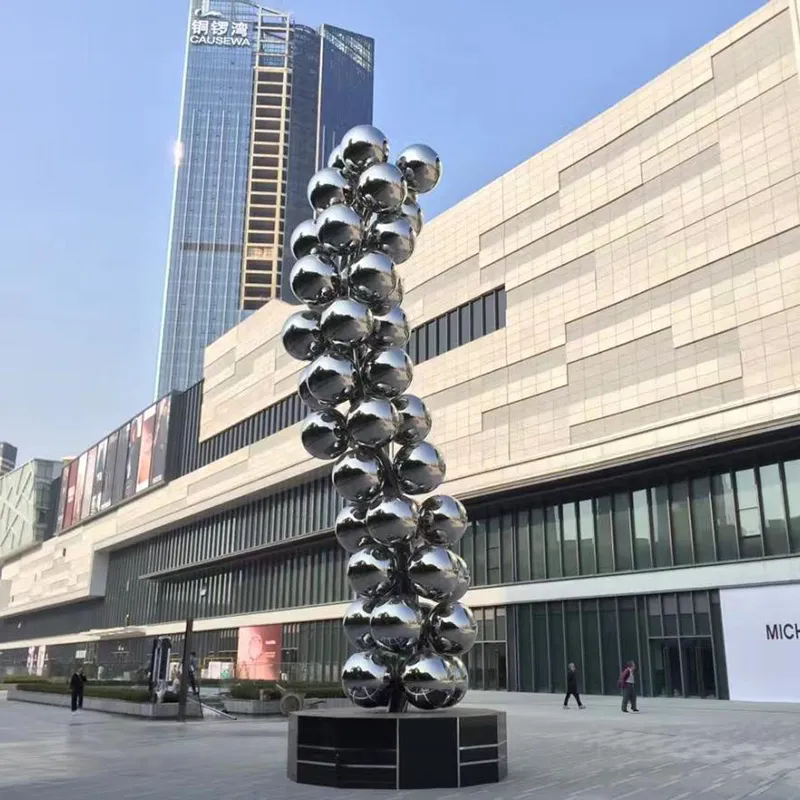The Elegance of Stainless Steel Sculptures: Crafting Art with Modern Materials
2024-08-23
In the realm of contemporary art and design, stainless steel sculptures stand out for their sleek, modern aesthetics and impressive durability. This material, known for its resistance to corrosion and its polished, reflective finish, offers a unique medium for artists and designers to explore innovative forms and expressions. In this blog, we will delve into the allure of stainless steel sculptures, exploring their benefits, creative possibilities, and how they are shaping the future of art.
What is Stainless Steel?
Stainless steel is an alloy of iron, chromium, and other elements that provide it with remarkable properties. The chromium content, typically at least 10.5%, creates a thin, invisible layer of chromium oxide on the surface, which protects the steel from rust and corrosion. This makes stainless steel a highly durable and low-maintenance material, ideal for both functional and decorative purposes.
Why Choose Stainless Steel for Sculptures?
1. Durability and Longevity: Stainless steel is incredibly resistant to weathering, rust, and corrosion. This makes it an excellent choice for sculptures displayed outdoors or in environments where exposure to moisture and pollutants is a concern. Unlike other materials that may deteriorate over time, stainless steel sculptures maintain their integrity and appearance for decades.
2. Aesthetic Appeal: The reflective quality of stainless steel provides a modern, sleek look that enhances the visual impact of sculptures. The polished surface can reflect light and its surroundings, creating dynamic interactions with viewers and environments. The material’s ability to be polished to a high shine or finished in various textures adds to its versatility in artistic expression.
3. Versatility in Design: Stainless steel can be fabricated into a wide range of forms and shapes, from intricate details to large-scale installations. Artists can use techniques like welding, casting, and machining to achieve the desired texture and form. Its strength allows for ambitious and innovative designs that might be challenging to execute with other materials.
4. Low Maintenance: The non-reactive surface of stainless steel requires minimal upkeep. Unlike other materials that may need regular sealing or cleaning, stainless steel sculptures generally only need occasional wiping to maintain their appearance. This makes them ideal for both public installations and private collections.
5. Environmental Benefits: Stainless steel is a highly recyclable material, which aligns with sustainable art practices. The ability to recycle stainless steel reduces waste and minimizes the environmental impact, contributing to a more eco-friendly approach to art and manufacturing.
Creative Possibilities with Stainless Steel Sculptures
1. Abstract Forms: Stainless steel’s reflective surface and pliability allow artists to create abstract forms that play with light and shadow. The material’s smooth finish can enhance the impact of geometric or organic shapes, resulting in sculptures that captivate and intrigue.
2. Interactive Installations: The reflective nature of stainless steel can be used to create interactive art installations. By reflecting the environment or viewers themselves, these sculptures can engage the audience in a dynamic dialogue and create a sense of connection between the art and its surroundings.
3. Kinetic Art: Stainless steel is an excellent material for kinetic sculptures, which incorporate movement into their design. The material’s strength and flexibility enable the creation of moving parts and mechanisms that can produce graceful and captivating motions.
4. Large-Scale Public Art: Due to its durability and low maintenance, stainless steel is often chosen for large-scale public art installations. From towering sculptures in urban plazas to intricate works in botanical gardens, stainless steel’s resilience makes it a suitable choice for high-profile projects.
5. Modern Interpretations of Classical Themes: Artists can use stainless steel to reinterpret classical themes and forms with a contemporary twist. The material’s modern aesthetic provides a fresh perspective on traditional subjects, blending timeless concepts with cutting-edge technology.
Examples of Notable Stainless Steel Sculptures
1. "The Bean" (Cloud Gate): Located in Chicago’s Millennium Park, Anish Kapoor’s "Cloud Gate," often referred to as "The Bean," is a prime example of stainless steel sculpture. Its highly polished surface reflects the city skyline and engages visitors in a captivating visual experience.
2. "The Kelpies": Designed by Andy Scott, these colossal horse head sculptures in Scotland are made of stainless steel and stand as a tribute to the mythological creatures of Scottish folklore. The Kelpies are an impressive feat of engineering and artistry.
3. "The Gates": Christo and Jeanne-Claude’s installation in Central Park, New York, featured thousands of gates wrapped in orange fabric. While the gates themselves were not stainless steel, the reflective properties of the steel poles supporting the fabric played a significant role in the installation’s impact.
Caring for Stainless Steel Sculptures
1. Regular Cleaning: Although stainless steel is low maintenance, periodic cleaning helps maintain its appearance. Use a mild detergent and soft cloth to clean the surface, avoiding abrasive materials that could scratch the finish.
2. Avoid Harsh Chemicals: Refrain from using harsh chemicals or abrasive cleaners, as these can damage the surface. Stick to products specifically designed for stainless steel care.
3. Inspect for Damage: Regularly check for any signs of damage or wear, especially if the sculpture is exposed to harsh environmental conditions. Promptly address any issues to prevent further deterioration.
Conclusion
Stainless Steel Sculptures represent a fusion of artistic vision and modern technology. With their durability, aesthetic appeal, and versatility, stainless steel sculptures offer endless possibilities for artists and designers. Whether used in public installations, private collections, or interactive art projects, stainless steel’s unique properties ensure that these sculptures stand the test of time and continue to captivate audiences for years to come. By embracing the potential of stainless steel, artists can push the boundaries of sculpture and create remarkable works that resonate with contemporary sensibilities and environments.



